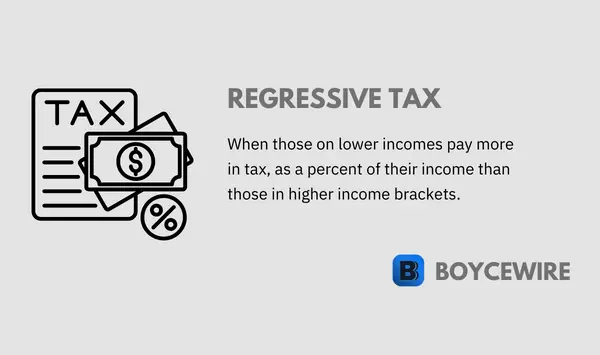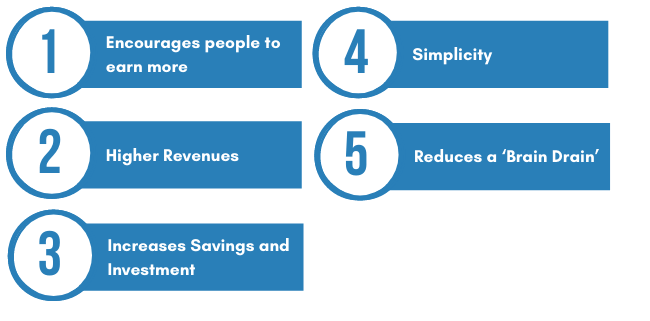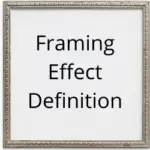Regressive Tax: Definition, Pros, Cons & Examples

What is a Regressive Tax
A regressive tax is where the tax rate falls disproportionately on those who are in the lower income brackets. In other words, lower-income households face a higher tax rate, as a percentage of their income, than higher-income groups. For example, a retail worker earning $20,000 may pay 40 percent in taxes. If there is a regressive tax, then those earning a higher amount will pay less as a percent. So an executive at a big multinational firm may earn $2 million, but only pay 20 percent in taxes.
The regressive tax contrasts with a progressive tax which increases alongside income. So the higher the individual’s income, the higher percentage of their salary they pay in taxes.
Key Points
- A regressive tax is where low income individuals pay a higher percentage of their incomes in taxes than richer individuals.
- A flat tax can also be regressive, as the rich and the poor pay the same value, yet as a percentage of their income, the rich pay far less.
- When a country adopts a regressive tax, it falls disproportionately on the poor, which can lead to inequality and political unrest.
It is very common to see in the news billionaires that have only paid 5 percent in taxes, whilst those on low incomes shell out over and above 20 percent. We may see this as a regressive tax, but it is not. Instead, the tax system has become so complicated and diverse that billionaires are able to take advantage of loopholes such as the loss carryover. This allows firms and individuals to write down their profits from one year to another, thereby reducing the tax to be paid.
There are many other clever ways that the rich reduce their effective tax rate, but the actual tax rates are in fact progressive. For instance, the US has a marginal tax rate that ranges from 10 percent for those earning under $10,000, to 37 percent for those earning over $510,000. Whilst many will see the rich pay less as a percentage, the actual tax rates are not regressive. Instead, the complexity of the tax system allows such individuals to manipulate the rate they pay.
The complexity of the tax system leads to calls for a flat tax system which is much simpler and less bureaucratic. However, a flat tax can also be seen as a regressive tax in itself. This is because one extra dollar to someone earning $1 million is worth much less to them than someone earning $10,000. So whilst the tax rate is the same, it is causing much more financial distress on low-income households.
A more obvious example is that of a sales tax. Although the rate may be flat across the board, it disproportionately affects the poor as they spend a higher proportion of their income on goods and services – whilst those on higher incomes have a greater tendency to save.
Regressive Tax Examples
Among many others, examples of a regressive tax include; sales tax, property tax, excise tax, tariffs, and government fees.

1. Sales Tax
The sales tax is usually set as a flat rate across the board. Whether the rate is 5 percent, 10 percent, or 20 percent, it means the same rate on all goods in the economy. So a sales tax on a Nike shirt is going to be the same for someone earning $20,000 a year at Walmart as an executive at Apple earning $1 million a year.
We can class this as a regressive tax as the Walmart employee earning $20,000 per year is going to spend a higher proportion of their income – perhaps even all of it. That means 100 percent of their income will be subject to the sales tax, so at a sales tax rate of 20 percent, that would equal 20 percent of their salary. However, the executive earning $1 million a year may only spend 15 percent of their income. So a 20 percent tax on that would equal 3 percent of their income spent on sales tax.
2. Property Tax
Property taxes are usually based on the value of the home, so would suggest that it is fairly neutral. The higher the house price, the higher the amount paid in tax. In the majority of cases, this would link in with higher income levels. Those who have a higher income will generally live in a house that is higher in value. This rings true in the majority of cases, but there is a regressive element to it.
Take two households that live next to each other. Both houses are worth the same, with one occupied by a young family with an income of $50,000 a year. They have a large mortgage out on the property and are tied in to its repayment for another 30 years. By contrast, the other household is a mature couple who work as executives at a bank earning $600,000 a year. The two homes are worth the same, yet the incomes of both are very different.
Both households will be paying the same amount in tax, but earning very different amounts – thereby suggesting it is a regressive tax in certain cases.
3. Excise Tax
An excise tax is a tax that is imposed during the manufacturing process – so before it even reaches the consumer. It is paid for by the manufacturer no matter if they sell the goods or not. The purpose is largely to limit the consumption of goods that are bad for the individual and/or create a negative externality. For example, smoking and alcohol are both bad for the individual, but can also harm others in the form of second-hand smoke or drink driving.
An excise tax is another flat tax, but one that can hurt the poor disproportionately. If it is set on goods that the poor predominantly purchase, then it will be regressive. For instance, low-income households tend to purchase more sugary drinks, so an excise tax on such goods will fall largely on the poor.
4. Tariff
When tariffs increase, it makes the products coming into the country more expensive. It is essentially an indirect tax that disproportionately hurts the poor. This is because those on lower incomes have to spend a higher proportion of their income on goods. So any increase in the price of those goods takes up a higher percentage of their incomes.
For example, an increase in the price of monthly groceries by $100 would represent an increase of 10 percent for someone of $1,000 a month. Yet for someone earning $10,000 a month, it would be an increase of only 1 percent. Therefore, those on higher incomes pay less as a percentage of their salary than the poor, thereby making tariffs a regressive tax.
5. Government Fees
Whether it’s applying for a driving license, fees for local parks, or other government services – the rate is the same. For example, a $30 fee for a new license is a higher percentage of someone’s income who is earning $1,500 a month, than someone earning $10,000 a month.
There are also road taxes which are generally higher for motor vehicles that produce higher rates of carbon dioxide. Old cars built in the 2000s are generally less fuel efficient and are therefore subject to higher tax rates. This makes it a regressive tax not only because poor households tend to only be able to afford older cars, but also because electric and more fuel efficient cars are more expensive.
Advantages of Regressive Tax

1. Encourages people to earn more
Under a regressive tax regime, people at higher income levels pay lower levels of tax. This creates an incentive for those in lower incomes to move up into higher brackets. By contrast, a progressive tax charges people higher amounts as they reach higher brackets. So for someone earning $39,000, it makes little sense to earn $50,000 which takes them into a bracket that pays an extra 10 percent.
A regressive tax eliminates this disincentive and actually does the opposite. It encourages people to move into more productive and higher-paying positions. At the same time, it can encourage entrepreneurs who are fed up of working in a dreary 9 to 5 job that they hate.
2. Higher Revenues
This may seem strange, but when taxes on the rich are lower, they tend not to take such extreme measures to avoid paying it. Instead of money going to the likes of Switzerland and Monaco, it is paid to the government in taxation. This is because the incentive to avoid it is lower. For example, tax avoidance costs the rich millions in lawyers and accountancy fees. As the rate of taxation is reduced, the cost-benefit of hiring those professionals also reduces.
3. Increases Savings and Investment
Under a regressive tax system, those who earn higher incomes tend to save more, thereby increasing the saving rate of the nation. In turn, those savings become capital which is available for businesses to invest in new productive and more efficient equipment.
4. Simplicity
A lot of regressive taxes are also flat taxes but are regressive in the fact that they are disproportionately paid for by lower-income households. Yet they are very simple in their implementation. For instance, the sales tax is straightforward – a 5 percent tax on each and every item. By contrast, the progressive income tax has to be calculated to determine the bracket, how much is earnt on that additional income, and how much is charged because it comes from capital. It requires thousands of workers just to administer such a system, but a flat regressive tax is simple.
5. Reduces a ‘Brain Drain’
When tax rates are more progressive, they can result in a loss of talent, also known as ‘brain drain’. This is where skilled professionals leave the country to find work elsewhere. By implementing a progressive system that taxes the rich at a higher rate, highly skilled professionals are incentivized to move elsewhere.
For example, someone who has worked 10 years to become a surgeon earning $150,000 a year may face a marginal tax rate of 50 percent. All that work and effort, only for half their income to be taken away. As a result, they may look to other nations that provide a more regressive tax system that is objectively fairer.
Disadvantages of Regressive Tax

1. Inequality
A regressive tax imposes a higher tax burden on those with lower incomes than those at higher incomes. Therefore, it creates a downwards pressure on the number of local income households can save. They are forced into paying a higher percentage of their incomes in tax, thereby leaving less for them to save. With lower savings, it becomes difficult to get onto the housing ladder and gain equity through the property. In turn, a poverty trap is created whereby low-income households are burdened by taxes – preventing them from accumulating capital.
2. Higher Prices
It goes without saying that the higher the tax, the higher the price. Yet for a regressive tax such as tariffs, it is often questioned. The price of a tariff will not always be passed on to the customer as the imported may take some of the cost. However, it falls predominantly on the consumer as businesses protect their profit margins.
The consumer also faces higher prices for other goods. For instance, excise taxes are imposed on goods such as sugary drinks, cigarettes, and alcohol – products that are often associated with low-income households.
3. Reduces Choice
Regressive taxes such as excise taxes, tariffs, and sales taxes, all help reduce demand for goods. That lower level of demand makes it more difficult for a wider variety of firms to make a profit. As prices as higher, there is less demand, and because there is less demand, there is less room for competition.
At the same time, smaller levels of demand make it more difficult for existing firms to fully benefit from the same economies of scale.
4. Political Unrest
Taxation will always be a moral issue. However, when it starts affecting a significant number of households disproportionately, people can become discontented. If they see, as they do today, millionaires and multinational companies paying little tax, it becomes a significant moral issue. We like to see a fair system, so when the public see the rich paying little tax, there is understandable outrage. In turn, we often see sharp turns in the politic sphere – either sharply to the left, or sharply to the right.
Related Topics
FAQs on Regressive Tax
The sales tax is one example of a regressive tax. It sets a tax on the sale of goods, but which is disproportionately paid by low income households. This is because low income households will spend a higher percentage of their incomes, thereby paying a higher percentage of their income in sales taxes. By contrast, rich households may pay more in absolute terms, but relatively, it is a much small amount of their income as they have a greater tendency to save.
A regressive tax is a tax which is paid for disproportionately by the poor as the burden of tax as a percent of income declines in richer households.
The sales tax is perhaps one of the most regressive of taxes as low income households spend a high proportion of their income on goods, thereby also paying a high amount of tax. By contrast, richer households have a greater tendency to save, so may only end up spending a small proportion of their incomes. Hence, they pay a lower percent of the income in sales taxes.
About Paul
Paul Boyce is an economics editor with over 10 years experience in the industry. Currently working as a consultant within the financial services sector, Paul is the CEO and chief editor of BoyceWire. He has written publications for FEE, the Mises Institute, and many others.

Further Reading
 Contribution Margin - The contribution margin is a financial metric that represents the amount of revenue available to cover fixed costs and contribute…
Contribution Margin - The contribution margin is a financial metric that represents the amount of revenue available to cover fixed costs and contribute…  Framing Effect: What it is, Types & Examples - The framing effect is a cognitive bias that impacts our decision making when said if different ways. In other words,…
Framing Effect: What it is, Types & Examples - The framing effect is a cognitive bias that impacts our decision making when said if different ways. In other words,…  Retained Earnings: Definition, Formula & Example - Retained earnings are the amount that a firm keeps after it has distributed dividends to shareholders.
Retained Earnings: Definition, Formula & Example - Retained earnings are the amount that a firm keeps after it has distributed dividends to shareholders. 